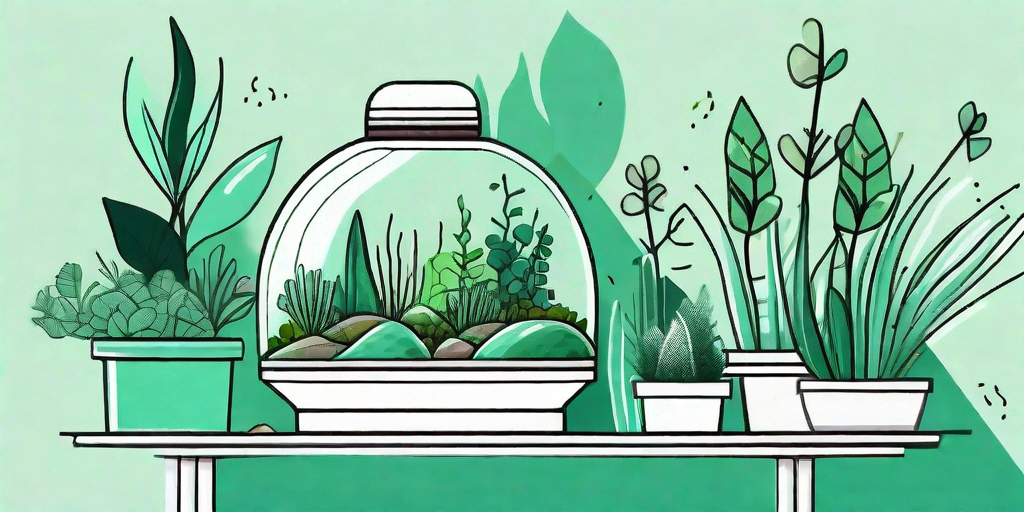
Welcome to the verdant world of terrariums, where the green thumb is both a badge of honor and a sign of a hobby well pursued. If you've ever dreamed of having a miniature rainforest on your coffee table, or a tiny desert in your study, then you're in the right place. Let's dive into the lush, leafy, and sometimes prickly realm of terrariums.
The Basics of Terrariums
What is a Terrarium?
A terrarium, in the simplest terms, is a miniature, self-sustaining garden enclosed in a clear container. Think of it as a fish tank, but for plants. It's a micro-ecosystem that brings a slice of nature into your home, office, or any indoor space that could use a touch of green.
There are two main types of terrariums: closed and open. Closed terrariums have a lid or seal that keeps moisture in, creating a humid environment perfect for tropical plants. Open terrariums, on the other hand, are ideal for plants that prefer a dry climate, such as cacti and succulents.
Why a Terrarium?
Aside from being a delightful addition to your décor, terrariums are also low-maintenance. They require minimal watering and can thrive in a variety of light conditions. Plus, the process of creating and caring for a terrarium can be a therapeutic and rewarding hobby.
Moreover, terrariums are a fantastic way to learn about different plant species and ecosystems. They're like living science projects that you can display proudly in your home. And let's face it, who wouldn't want a tiny jungle or desert that fits on a shelf?
Creating Your Terrarium
Choosing Your Container
The first step in creating your terrarium is choosing the right container. Glass containers are the most popular choice because they allow you to see your miniature garden from all angles. They can be anything from a simple glass jar to an elaborate geometric terrarium.
The size and shape of your container will depend on the type of plants you want to grow and the design you have in mind. Remember, the container sets the stage for your mini ecosystem, so choose wisely!
Selecting Your Plants
When it comes to choosing plants for your terrarium, the world is your oyster. Well, your oyster as long as it fits in a jar and doesn't need a ton of sunlight. Some popular choices include ferns, mosses, succulents, and air plants.
It's important to choose plants that have similar light and water requirements. For instance, don't pair a cactus with a fern in the same terrarium. That's like putting a camel and a fish in the same room and expecting them to get along. It's just not going to work.
How to Build a Terrarium
Step-by-Step Guide
-
Start by adding a layer of pebbles or gravel at the bottom of your container for drainage.
-
Add a layer of activated charcoal to keep the water fresh and prevent mold and bacteria growth.
-
Next, add a layer of potting soil. Make sure it's deep enough for your plants' roots.
-
Now it's time to add your plants. Start with the largest one and work your way down to the smallest.
-
After planting, you can add decorative elements like rocks, shells, or figurines.
-
Finally, give your terrarium a good watering, and place it in a location with indirect sunlight.
Caring for Your Terrarium
Watering
Watering your terrarium is a delicate art. Too much water can lead to root rot, while too little can leave your plants parched. As a general rule, closed terrariums need watering once every two to four weeks, while open terrariums need watering once a week.
Remember, it's better to underwater than overwater. If you're unsure, check the soil. If it's dry to the touch, it's time to water. If it's damp, hold off on the watering can.
Lighting
Most terrarium plants prefer indirect light. Direct sunlight can cause your terrarium to overheat and your plants to burn. If you notice your plants turning yellow or brown, they might be getting too much light. On the other hand, if they're stretching towards the light or losing their color, they might not be getting enough.
Remember, every plant is different. Some might need more light than others, so it's important to do your research and monitor your plants closely.
FAQs
What if my terrarium plants are dying?
If your plants are dying, it could be due to a variety of reasons. They might be getting too much or too little light, or too much or too little water. It could also be due to poor drainage or a lack of nutrients. Check all these factors and adjust as necessary.
Can I put my terrarium outside?
While you can put your terrarium outside, it's generally not recommended. Outdoor conditions can be unpredictable, and terrariums are best suited for stable indoor environments.
Can I use any glass container for my terrarium?
Yes, you can use any clear glass container for your terrarium. However, it's best to use a container with a lid if you're creating a closed terrarium.
Conclusion
Creating a terrarium is an art, a science, and a labor of love. It's a way to bring a piece of the natural world into your home, and a hobby that can bring endless joy and satisfaction. So go ahead, green up your space and create your own stunning terrarium. Your future mini jungle, desert, or forest awaits!















